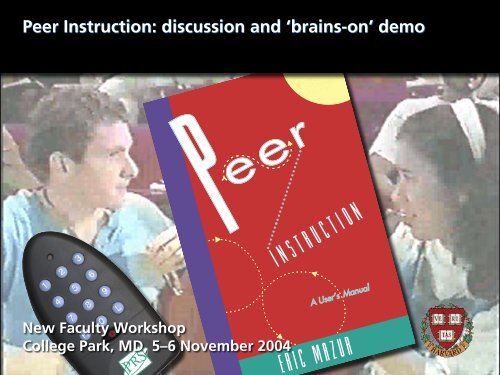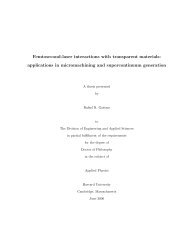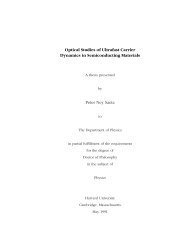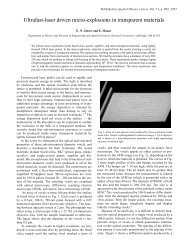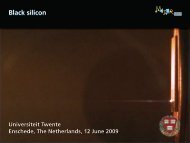Peer Instruction ConcepTest data - Mazur Group
Peer Instruction ConcepTest data - Mazur Group
Peer Instruction ConcepTest data - Mazur Group
- No tags were found...
You also want an ePaper? Increase the reach of your titles
YUMPU automatically turns print PDFs into web optimized ePapers that Google loves.
Let’s try it!It’s easy to fire up the audience!
Let’s try it!The distance between the atoms increases uniformly
Let’s try it!A boat carrying a large boulder isfloating on a small pond. The boulderis thrown overboard and sinks to thebottom of the pond.After the boulder sinks to the bottom of the pond, the level ofthe water in the pond is1. higher than2. the same as3. lower thanit was when the boulder was in the boat.
Let’s try it!When we hold a page of printed text in front of a mirror, thetext on the image in the mirror runs from right to left:The New York Times
Let’s try it!When we hold a page of printed text in front of a mirror, thetext on the image in the mirror runs from right to left:The New York TimesWhy is it that right and left are interchanged and not top andbottom? Because:1. the mirror is oriented vertically.2. we have two eyes in the horizontal plane.3. the Earth’s gravitation is directed downward.4. a habit we have when looking at images in a mirror.5. It only appears to run from left to right.
Let’s try it!It’s “simple” only if you know the answer
Feedback methodsFlashcards: simple and effectiveA BC D
Feedback methodsFlashcards: simple and effectiveA BC DMeltzer and Mannivanan, South Eastern Louisiana University
Feedback methodsInfrared transmitters (PRS): easy collection of <strong>data</strong>
Feedback methodsInfrared transmitters (PRS): easy collection of <strong>data</strong>Kristy Beauvais, Concord Carlisle High School
Feedback methodsnear future: wireless classroom
Problems with problemsOn a Saturday afternoon, you pull into a parking lot with unmeteredspaces near a shopping area. You circle around, but thereare no empty spots. You decide to wait at one end of the lot,where you can see (and command) about 20 spaces.
Problems with problemsOn a Saturday afternoon, you pull into a parking lot with unmeteredspaces near a shopping area. You circle around, but thereare no empty spots. You decide to wait at one end of the lot,where you can see (and command) about 20 spaces.How long do you have to wait before someone frees up aspace?
Problems with problemsOn a Saturday afternoon, you pull into a parking lot with unmeteredspaces near a shopping area. You circle around, but thereare no empty spots. You decide to wait at one end of the lot,where you can see (and command) about 20 spaces.How long do you have to wait before someone frees up aspace?Requires:AssumptionsDeveloping a modelApplying that model
Problems with problemsOn a Saturday afternoon, you pull into a parking lot with unmeteredspaces near a shopping area. You circle around, but thereare no empty spots. You decide to wait at one end of the lot,where you can see (and command) about 20 spaces. On averagepeople shop for 2 hours.How long do you have to wait before someone frees up aspace?
Problems with problemsOn a Saturday afternoon, you pull into a parking lot with unmeteredspaces near a shopping area. You circle around, but thereare no empty spots. You decide to wait at one end of the lot,where you can see (and command) about 20 spaces. On averagepeople shop for 2 hours.How long do you have to wait before someone frees up aspace?Requires:Developing a modelApplying that model
Problems with problemsOn a Saturday afternoon, you pull into a parking lot with unmeteredspaces near a shopping area. You circle around, but thereare no empty spots. You decide to wait at one end of the lot,where you can see (and command) about 20 spaces. On averagepeople shop for 2 hours.Assuming people leave at regularly-spaced intervals, how longdo you have to wait before someone frees up a space?
Problems with problemsOn a Saturday afternoon, you pull into a parking lot with unmeteredspaces near a shopping area. You circle around, but thereare no empty spots. You decide to wait at one end of the lot,where you can see (and command) about 20 spaces. On averagepeople shop for 2 hours.Assuming people leave at regularly-spaced intervals, how longdo you have to wait before someone frees up a space?Requires:Applying a (new) model
Problems with problemsOn a Saturday afternoon, you pull into a parking lot with unmeteredspaces near a shopping area, where people are know toshop, on average, for 2 hours. You circle around, but there areno empty spots. You decide to wait at one end of the lot, whereyou can see (and command) about 20 spaces.How long do you have to wait before someone frees up aspace?
Problems with problemsOn a Saturday afternoon, you pull into a parking lot with unmeteredspaces near a shopping area, where people are know toshop, on average, for 2 hours. You circle around, but there areno empty spots. You decide to wait at one end of the lot, whereyou can see (and command) about 20 spaces.How long do you have to wait before someone frees up aspace?t wait=T shopN spaces
Problems with problemsOn a Saturday afternoon, you pull into a parking lot with unmeteredspaces near a shopping area, where people are know toshop, on average, for 2 hours. You circle around, but there areno empty spots. You decide to wait at one end of the lot, whereyou can see (and command) about 20 spaces.How long do you have to wait before someone frees up aspace?Requires:Using a calculatort wait=T shopN spaces
<strong>Peer</strong> <strong>Instruction</strong><strong>ConcepTest</strong>:1. Question2. Thinking3. Individual answer4. <strong>Peer</strong> discussion5. Revised/<strong>Group</strong> answer6. Explanation
<strong>Peer</strong> <strong>Instruction</strong>Individual answers160120before discussionjustguessingcount80notquite sureprettysure400ABCanswer
<strong>Peer</strong> <strong>Instruction</strong>group answers160after discussionnotquite surejustguessing120count8040prettysure0ABCanswer
<strong>Peer</strong> <strong>Instruction</strong><strong>ConcepTest</strong> <strong>data</strong>
<strong>Peer</strong> <strong>Instruction</strong><strong>ConcepTest</strong> <strong>data</strong>
<strong>Peer</strong> <strong>Instruction</strong><strong>ConcepTest</strong> <strong>data</strong>
<strong>Peer</strong> <strong>Instruction</strong><strong>ConcepTest</strong> <strong>data</strong>
<strong>Peer</strong> <strong>Instruction</strong><strong>ConcepTest</strong> <strong>data</strong>
<strong>Peer</strong> <strong>Instruction</strong><strong>ConcepTest</strong> <strong>data</strong>
<strong>Peer</strong> <strong>Instruction</strong><strong>ConcepTest</strong> <strong>data</strong>
<strong>Peer</strong> <strong>Instruction</strong>optimum range: 30–70%
Research: providing the basis for changewho benefits from the <strong>ConcepTest</strong>s?100individual CT score (%)8060402005060708090100final grade (%)
Research: providing the basis for changewho benefits from the <strong>ConcepTest</strong>s?100individual CT score (%)8060402005060708090100final grade (%)
Research: providing the basis for changeeven the best students are challenged100individual CT score (%)8060402005060708090100final grade (%)
Research: providing the basis for changeeven the best students are challenged100individual CT score (%)8060402005060708090100final grade (%)
Why does it work?Students:• promotes thinking• helps uncover and address misunderstanding• boosts confidence
Why does it work?Students:• promotes thinking• helps uncover and address misunderstanding• boosts confidenceFaculty:• change of format, not content• with existing questions, little effort• adaptable
Funding:National Science Foundationfor a copy of this presentation:http://mazur-www.harvard.edu


